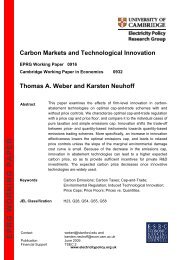Nuclear New Build in the UK a personal view William J. Nuttall ...
Nuclear New Build in the UK a personal view William J. Nuttall ...
Nuclear New Build in the UK a personal view William J. Nuttall ...
You also want an ePaper? Increase the reach of your titles
YUMPU automatically turns print PDFs into web optimized ePapers that Google loves.
<strong>Nuclear</strong> <strong>New</strong> <strong>Build</strong> <strong>in</strong> <strong>the</strong> <strong>UK</strong><br />
a <strong>personal</strong> <strong>view</strong><br />
<strong>William</strong> J. <strong>Nuttall</strong><br />
University Senior Lecturer Technology Policy<br />
A shared post of Judge Bus<strong>in</strong>ess School and Cambridge<br />
University Eng<strong>in</strong>eer<strong>in</strong>g Department<br />
27 October 2011<br />
Copyright WJ <strong>Nuttall</strong> (except identified third party material)
Structure of my remarks:<br />
• <strong>UK</strong> Policy For <strong>New</strong> <strong>Build</strong> 2008-2011<br />
• Problems Before Fukushima<br />
• Problems From Fukushima<br />
• A comment on <strong>the</strong> Fukushima <strong>in</strong>cident itself
Economics<br />
Energy<br />
Policy<br />
Security of<br />
Supply<br />
Environment
<strong>New</strong> capacity needed 2015<br />
demand<br />
Start of ETS<br />
With thanks to D. <strong>New</strong>bery EPRG<br />
2020<br />
SKM (2008)<br />
mid-scenario<br />
projection<br />
•4
With thanks to D <strong>New</strong>bery EPRG, Data from DECC EMR 2011<br />
CCGT at<br />
<strong>Nuclear</strong> cheaper<br />
than any w<strong>in</strong>d<br />
power<br />
£20/t CO 2,<br />
10% capital
<strong>Nuclear</strong> White Paper 2008<br />
Labour Government Formally<br />
Supports <strong>Nuclear</strong> <strong>New</strong> <strong>Build</strong>
2008 White Paper – ma<strong>in</strong> measures<br />
1. Generic Design Assessment<br />
2. Justification and Strategic Sit<strong>in</strong>g Assessment<br />
3. Statement of National Need – National Policy<br />
Statements<br />
Consequence: future local approval processes (<strong>in</strong>clud<strong>in</strong>g public <strong>in</strong>quiries)<br />
will not be allowed to question:<br />
• Design safety<br />
• National need for nuclear power, or<br />
• Whe<strong>the</strong>r this is <strong>the</strong> best place to build<br />
Local plann<strong>in</strong>g approval has been a difficult issue for <strong>UK</strong> <strong>in</strong>frastructure build
2010 Conservative/Liberal<br />
Democrat Coalition<br />
Government Agreement:<br />
“We have agreed a process that will allow Liberal<br />
Democrats to ma<strong>in</strong>ta<strong>in</strong> <strong>the</strong>ir opposition to nuclear<br />
power while permitt<strong>in</strong>g <strong>the</strong> government to br<strong>in</strong>g<br />
forward <strong>the</strong> national plann<strong>in</strong>g statement for<br />
ratification by parliament so that new nuclear<br />
construction becomes possible.” (Emphasis added)
<strong>UK</strong> Timel<strong>in</strong>e, Pre-Fukushima<br />
Source: DECC <strong>UK</strong>
2. Difficult realities before<br />
Fukushima
Capital Costs Dom<strong>in</strong>ate<br />
20%<br />
Operations and<br />
Ma<strong>in</strong>tenance<br />
The fuel 14%:<br />
57%<br />
11%<br />
32%<br />
14% Uranium<br />
Fuel costs<br />
Fuel Preparation<br />
Waste (spent fuel)<br />
66%<br />
Capital<br />
<strong>in</strong>vestment<br />
Note: ma<strong>in</strong> chart components of lifetime levelised cost (10% real post‐tax discount<br />
rate assumed) Ref: DTI Energy Re<strong>view</strong> – cm6887 (July 2006).<br />
Raw uranium costs are only a m<strong>in</strong>or part (about 5%) of <strong>the</strong> total costs. Ref: <strong>Nuclear</strong><br />
Power <strong>in</strong> <strong>the</strong> OECD, IEA (2001)
Economic Risks Matter to Investors<br />
The fundamental economic risks of nuclear power are:<br />
• High costs of capital (high discount rates and rates of<br />
return)<br />
• Overrun of construction phase (lost time is lost money)<br />
• Future electricity prices (as for any power technology)<br />
• Changes of safety or environmental regulation dur<strong>in</strong>g<br />
plann<strong>in</strong>g and construction<br />
• Political risk and public acceptance problems<br />
• Risk of a low carbon price<br />
• Poor plant reliability <strong>in</strong> operational phase (low load factor)<br />
Blue font denotes risks occurr<strong>in</strong>g before first operations
Impact of EU Policy - EU 20:20:20 by 2020<br />
B<strong>in</strong>d<strong>in</strong>g EU targets affect<strong>in</strong>g electricity:<br />
• 20% of total energy consumed to be supplied from<br />
renewables by 2020 – (<strong>UK</strong> commitment is 15%. Imply<strong>in</strong>g<br />
30%+ of electricity from renewables)<br />
• 20% reduction <strong>in</strong> greenhouse gas emissions by 2020<br />
(<strong>UK</strong> commitment is 16%)<br />
• In addition <strong>the</strong>re is a non-b<strong>in</strong>d<strong>in</strong>g target to reduce<br />
primary energy use by 20%<br />
TENSION<br />
See: http://europa.eu/rapid/pressReleasesAction.doreference=IP/08/80 and<br />
http://ec.europa.eu/energy/energy_policy/
Before Fukushima High<br />
Costs and Major Economic<br />
Risks Were Threaten<strong>in</strong>g<br />
<strong>Nuclear</strong> <strong>New</strong> <strong>Build</strong> <strong>in</strong> <strong>the</strong> <strong>UK</strong>
<strong>UK</strong> Electricity Market Reform 2011<br />
In December 2010 <strong>the</strong> <strong>UK</strong> Government issued a consultation<br />
paper propos<strong>in</strong>g four important market changes:<br />
1. Establish a stable and significant floor to <strong>the</strong> carbon price<br />
2. <strong>New</strong> ‘Contract for Difference’ Feed <strong>in</strong> Tariffs for low carbon electricity<br />
generation <strong>in</strong>vestments<br />
3. Capacity Payments - mov<strong>in</strong>g away from energy only markets<br />
4. Emissions Performance Standard which would block new unabated<br />
coal generators<br />
These are arguably <strong>the</strong> most radical Eight proposals new build <strong>in</strong> sites <strong>UK</strong> energy rema<strong>in</strong><br />
policy for more than 20 years. They on-track are now for at new <strong>the</strong> nuclear heart of power <strong>the</strong><br />
2011 Electricity Market Reform White by 2025 Paper. Are <strong>the</strong>se<br />
measures sufficient to make nuclear new build viable
<strong>UK</strong> Carbon Price Floor<br />
(<strong>in</strong> Budget of 3/11)<br />
to £70/t by 2030<br />
As at 1 Jun 2011<br />
Source: EEX and DECC Consultation. Chart prepared D <strong>New</strong>bery EPRG
‘No Subsidy’ for <strong>Nuclear</strong> Power<br />
A long-stand<strong>in</strong>g <strong>UK</strong> Government axiom ‘clarified’<br />
“To be clear, this means that <strong>the</strong>re will be no levy, direct<br />
payment or market support for electricity supplied or<br />
capacity provided by a private sector new nuclear<br />
operator, unless similar support is also made available<br />
more widely to o<strong>the</strong>r types of generation.”<br />
Rt Hon. Chris Huhne MP, Secretary of State for Energy<br />
and Climate Change<br />
October 2010<br />
Policy becomes No Special Subsidy for<br />
<strong>Nuclear</strong> Power
<strong>UK</strong> Consequences of Fukushima
Government<br />
• <strong>UK</strong> Government resolve <strong>in</strong> favour of nuclear new<br />
build appears to be undim<strong>in</strong>ished<br />
• Both Government and opposition cont<strong>in</strong>ue to<br />
support nuclear new build<br />
• The orig<strong>in</strong>al 2010 timel<strong>in</strong>e has clearly been pushed<br />
back by Fukushima and <strong>the</strong> Weightman Re<strong>view</strong>,<br />
but project proponents suggest that any delay will<br />
be m<strong>in</strong>or.
Energy Companies<br />
• Initiative lies with <strong>the</strong> energy company consortia –<br />
here are <strong>the</strong> ma<strong>in</strong> risks to <strong>UK</strong> new build<br />
• Members of <strong>the</strong>se <strong>in</strong>ternational consortia are<br />
affected by politics and <strong>the</strong> bus<strong>in</strong>ess environment<br />
<strong>in</strong> <strong>the</strong>ir home markets. German decisions are<br />
particularly relevant<br />
• 26 October 2011 F<strong>in</strong>ancial Times Reports that<br />
Project Horizon consortium is seek<strong>in</strong>g a €5 Billion<br />
<strong>in</strong>vestment from a reactor technology vendor <strong>in</strong><br />
return for a 25% project stake.
A Clos<strong>in</strong>g remark on Fukushima<br />
Concern<strong>in</strong>g <strong>the</strong> Fukushima <strong>in</strong>cident itself.<br />
I see two schools of thought:<br />
1. TMI and Chernobyl were unforced errors of <strong>the</strong> nuclear<br />
<strong>in</strong>dustry. Fukushima, however, was a side consequence of a<br />
truly horrendous natural disaster which killed many thousands<br />
of people. Hence Fukushima is much less troubl<strong>in</strong>g than those<br />
earlier accidents.<br />
2. Alternatively, Fukushima reveals <strong>the</strong> worst k<strong>in</strong>d of design basis<br />
error. An <strong>in</strong>dustry which makes such basic errors <strong>in</strong> its<br />
assumptions simply cannot be trusted.
Thank You






